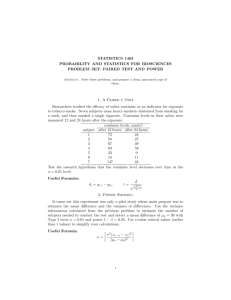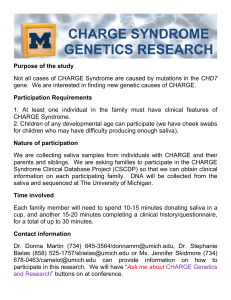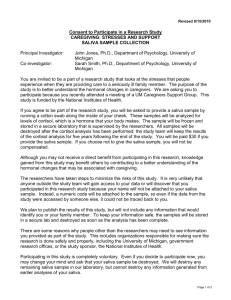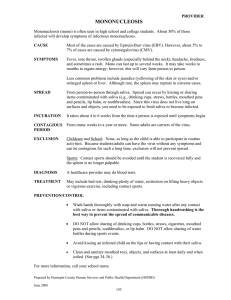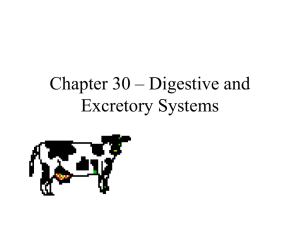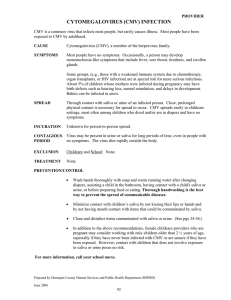Anna Vigeland BB 317 Article Review:
advertisement
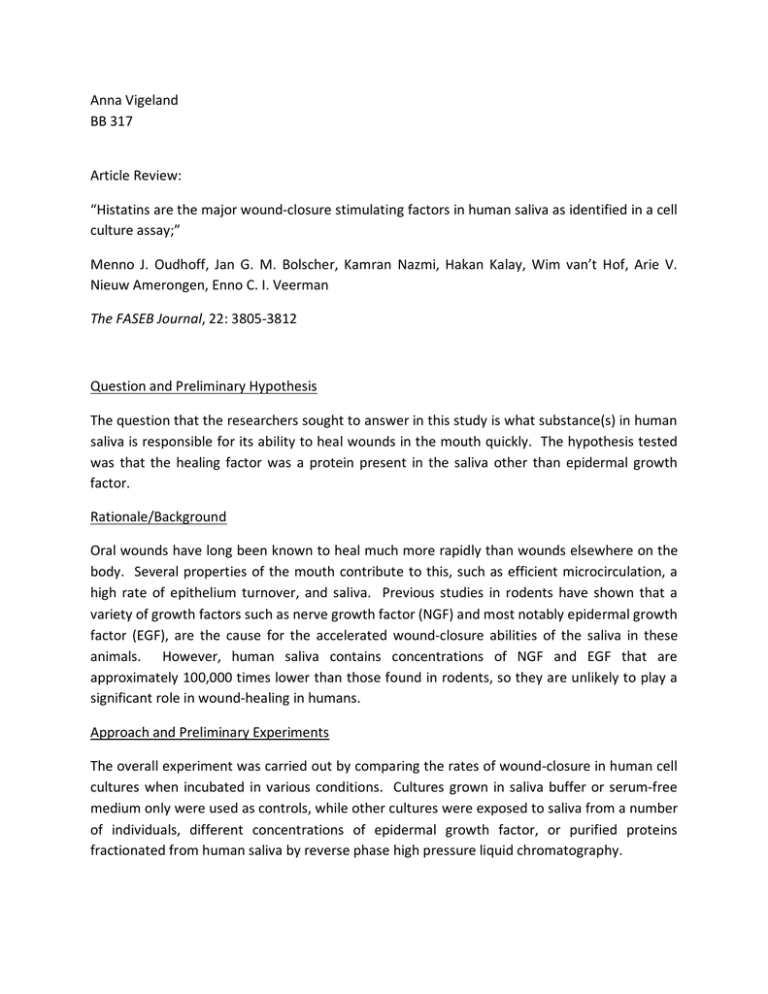
Anna Vigeland BB 317 Article Review: “Histatins are the major wound-closure stimulating factors in human saliva as identified in a cell culture assay;” Menno J. Oudhoff, Jan G. M. Bolscher, Kamran Nazmi, Hakan Kalay, Wim van’t Hof, Arie V. Nieuw Amerongen, Enno C. I. Veerman The FASEB Journal, 22: 3805-3812 Question and Preliminary Hypothesis The question that the researchers sought to answer in this study is what substance(s) in human saliva is responsible for its ability to heal wounds in the mouth quickly. The hypothesis tested was that the healing factor was a protein present in the saliva other than epidermal growth factor. Rationale/Background Oral wounds have long been known to heal much more rapidly than wounds elsewhere on the body. Several properties of the mouth contribute to this, such as efficient microcirculation, a high rate of epithelium turnover, and saliva. Previous studies in rodents have shown that a variety of growth factors such as nerve growth factor (NGF) and most notably epidermal growth factor (EGF), are the cause for the accelerated wound-closure abilities of the saliva in these animals. However, human saliva contains concentrations of NGF and EGF that are approximately 100,000 times lower than those found in rodents, so they are unlikely to play a significant role in wound-healing in humans. Approach and Preliminary Experiments The overall experiment was carried out by comparing the rates of wound-closure in human cell cultures when incubated in various conditions. Cultures grown in saliva buffer or serum-free medium only were used as controls, while other cultures were exposed to saliva from a number of individuals, different concentrations of epidermal growth factor, or purified proteins fractionated from human saliva by reverse phase high pressure liquid chromatography. All wound-closure experiments were conducted by growing TR146 cells to confluence in SFM, scratching a small wound in the layer of cells, and then incubating the cell culture in either SFM containing an experimental factor or in saliva buffer. The width of each scratch was measured immediately and sixteen hours after the initial damage and after sixteen hours of exposure to experimental conditions. Relative wound closure rates were calculated by dividing the change in the width of the scratch after sixteen hours of incubation in an experimental serum by the change in the width after sixteen hours of incubation in a control serum. Core Findings The researchers first determined the extent to which EGF accelerates wound-closure in humans. Using the techniques described above, EGF was found to accelerate wound-closure to the same rate as regular saliva only when in concentrations much higher than those naturally occurring in humans. Adding EGF receptor (EGFR) inhibitor to the serum reduced the activity of serum containing only rhEGF or saliva buffer, indicating a level of endogenous EGFR activation, but had no effect on the activity of saliva. Thus, EGF was deemed to not be an important healing factor in human saliva. Fractions from human saliva were then tested on cell cultures in order to deduce the true wound-closure factor. The fraction that was found to cause accelerated wound-closure contained Htn1 gene products, which include the histatins Hst1 and Hst2. Hst1, Hst2, and the Hst2 enantiomer D-Hst2 were artificially synthesized along with Htn2 gene products Hst3 and Hst5 (lacking the 8 C-terminal residues of Hst3), and were tested on cell cultures. Hst1, Hst2, and Hst3 significantly increased the rate of wound-closure, demonstrating that histatins do in fact accelerate healing in concentrations found naturally in saliva, while D-Hst2 and Hst5 did not, indicating that histatin interaction for wound-closure in stereospecific and that the Cterminus of Hst3 is essential for its wound-closure activity. Extension of Findings After determining that histatins are responsible for the rapid wound-closure properties of human saliva, the researches continued to investigate the mechanisms of histatins to cause such accelerated healing. Hst2 was found to induce epithelial cell migration, which is important in the healing of wounds. D-Hst2 also was found to act as well as a fungicide as L-Hst2, and Hst5 functions very effectively as a fungicide also. These findings demonstrate that the woundclosure mechanisms of the histatins are different than the antifungal mechanisms, as the fungicidal activity is not stereospecific and does not require the C-terminus of Hst3. Measurements of the level of histatins present in serum after twenty hours of incubation with a cell culture revealed that Hst1, Hst2, and Hst3 are depleted (by interaction with epithelial cells) over time while D-Hst2 is not. Fluorescently labeled Hst1 proteins were shown to be present in high concentrations within the cells at 37° C whereas at 4° C the fluorescence occurred in low levels around the exterior of the cells, indicating a membrane receptor internalization mechanism. When the energy charge of the cells was depleted, internalization of Hst1 did not occur, meaning that the internalization is energy-dependent. Finally, when inhibitors for several signaling pathways were introduced to the experimental serums, the inhibition of the ERK1/2 pathway by U0126 was found to halt wound-closure activity, suggesting that the ERK1/2 signal transduction pathway is involved in histatin-mediated wound-closure. Evaluation of Evidence, Perspective, and Implications The experiment was conducted thoroughly and used several controls to ensure accurate results. Each of the tests done with various factors from human saliva or saliva buffer clearly demonstrate that epidermal growth factor is not the major contributor to wound-closure in human saliva, while histatins do play an important role in human saliva’s wound-closure activity. It cannot be concluded that histatins are the only factors contributing to the healing properties of human saliva, but the article does not claim as much and only states what the evidence shows, which is that histatins are far more significant than EGF for oral wound-closure in humans, as opposed to their rodent counterparts. Some properties of the mechanisms of histatin-induced wound-closure are described, but no specific conclusions can be or are drawn. The findings presented in this article are important because the factors identified apply directly to humans and are not an animal analogue of unknown similarity. As mentioned by the authors of the paper, histatins are relatively stable molecules compared to EGF and can be readily massproduced, so they have potential to be developed for medical use as a highly effective healing agent.
